Milford Sound Boat Cruise
Stay with me, guys. We’re finally getting out of Queenstown and on to other parts of the South Island now. It was a sad departure because only a handful of the old crew was left, and Caas had already returned to Christchurch to finish his studies. So the new bus out of Queenstown wasn’t quite as friendly and crazy as the first one had been. Oh well. I was a bit bummed to leave Queenstown behind, but I knew that if I didn’t leave within a few days, I would be tempted to stay there for another couple of months, and then it would be too late to explore everywhere else.
We had a fairly early start that morning - nothing as miserable as a 6 or 7am departure, but somewhere in the ballpark of 8 or 8:30 - so that meant setting the alarm clock and making sure all of my stuff was good to go the night before. I was pleasantly surprised to see some familiar faces when we boarded, so I stuck with people like Mirva and Natalie for the trip to Milford Sound. Now, Milford Sound is not actually a “sound” in scientific terms - more like a fjord, apparently - but it’s reputed to be one of the most beautiful spots of New Zealand. I had been looking forward to seeing it because so many people had been telling me about their experiences there. I didn’t want to put my expectations too high in case it was super disappointing, but I had a feeling that it was going to be amazing.
To get to Milford Sound, we had to travel northwest of Queenstown through Te Anau, which is a little backwards when you look at the route map. You would think that it’d make more sense to hit that area before Queenstown and then work your way south instead of having to go up and come down again, but then again, Stray isn’t the most organized travel company in the world. I’m sure there’s a logical reason for doing it that way somewhere.
The trip to Te Anau was as predictable as you’d expect. Our new guide was a driver-in-training named Tutu, who was being coached along by Daisy. Some of you might remember that I was briefly on a bus with Daisy between Taupo and Tongariro National Park, so it was a bit surreal to see him again after all of the other stuff that had happened since then. Tutu and Daisy seemed pretty cool even though I didn’t really have much of a chance to talk to them. Tutu was a chill, younger guy who appeared to know what he was doing 95% of the time, and Daisy just chimed in that other 5% to add supplementary information. Our new bus was named “Bex,” and even though it didn’t have as many cool features as “Richard,” it was still pretty comfy and didn’t break down on us or anything.
We were all a little quiet and groggy for the first leg of the ride because backpackers, in general, are not big on mornings, so the ride to Te Anau mostly involved us staring out the windows and listening to our iPods. Te Anau (pronounced Teh AH-Now) is a nice little town not too far out of Queenstown. It was a definite change of pace after the last couple of days, but in a good way. We only stopped there for about an hour, so it’s hard to say if there’s anything really in Te Anau, but it’s on a gorgeous lake and has a generally peaceful vibe to it. I had originally planned on hopping off there for an extra night instead of continuing on to Milford Sound right away because I wanted to see the glow worm caves there, but since Stray’s scheduling was lame (as usual), that would have meant staying several extra days. Even though I was disappointed about that, I knew that I would get to see the Waitomo Caves up in the North Island eventually, and those are, apparently, just as good. Next time, I suppose.
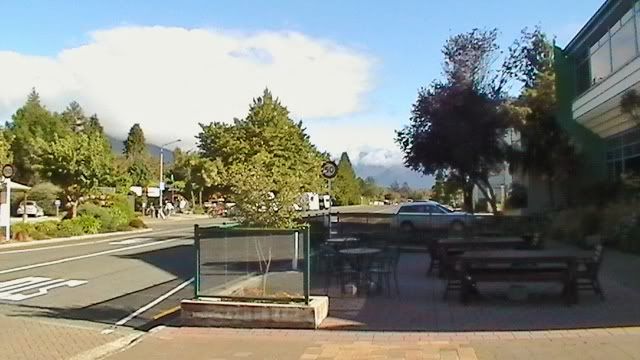

Downtown Te Anau, booking office on the right
There’s generally a set formula once you’re on the Stray bus: get on, go through roll call, announce the itinerary, drive, pass around a clipboard for accommodation that night, pass along a clipboard to sign up for upcoming activities, and then arrive at the destination. For some reason, the plan deviated from this routine between Queenstown and Milford Sound because instead of signing up for the Milford Sound cruise and/or Stewart Island ferry on the bus and then allowing the driver to book it for you, we had to do it ourselves. Normally, I wouldn’t really mind about that because it’s a pretty easy process, but since the entire bus had to do the exact same thing in a tiny little office, that meant an incredibly long line for just an hour-long stop. Luckily, I had the foresight to go eat first and then head back to the Real Journeys booking office after the rush had ended, thereby beating both lines. Daisy (who is a great lover of pies) had pointed out one bakery in particular, so I decided to stop there for lunch.
It turned out to be a fabulous idea because as soon as I walked in the door, my eyes immediately zoomed in one thing - Cornish pasties. Now, pasties are probably my favorite things in the whole wide world, and I firmly believe that they can cure polio and end global warming, so I was thrilled to see them on the menu. My grandmother had the absolute best recipe for them, and Mom and I have tried out best to copy her results. I have no delusions that our version is even close to how they were originally supposed to taste, but since they’re so good, I honestly don’t care. Needless to say, I was intrigued to try the official kind in a real bakery. Jodie informed me that the only way to tell that it’s a genuine Cornish pastie is to see if it has the ridges on the top like a football. I guess they were originally eaten by coal miners as a lunch snack, and since their hands were covered with coal dust, those outer ridges were designed to give them something to hold onto while they ate. After they were done, that part was left and thrown away. Makes sense. So I ordered the pastie, and although it was good and probably the most authentic version outside of the UK, I still prefer the kind that I grew up with. This kind was too complicated with carrots and extra seasoning inside, and the kind back home is just salt and pepper to taste, which means it’s not as salty. Good to know that our version is even better than the official one.

Heaven
The other place that I had wanted to stop at in Te Anau was the Redcliff Bar and Restaurant. To explain why, I’ll just lift an entire passage out of my Lord of the Rings Guidebook: “During filming in the area, the stars frequented the café, and part-owner Megan Harvey has an autographed T-Shirt to prove it. One evening, dinner coincided with poetry-reading night. After various recitations, a deep voice resounded, reciting a Shakespearean sonnet. The reading finished, the audience applauded, and John Rhys-Davies (Gimli) took a deep bow and left.” Since that was literally two minutes away from the bakery, I thought I’d be a good idea to check that place out as well. Unfortunately, it was closed on that particular day, but it wouldn’t have really mattered anyway. The menu had been left outside, and everything on it was way outside of my price range. It looked like a pretty fancy place with $40 steaks and whatnot, so it was probably for the best that I wasn’t able to stop in. I was able to take plenty of pictures of the front, though, so that was all I really needed.




I'm such a nerd
After all of that, I finally made it back to the bookings office and got my ticket for the Milford Sound cruise. Since you have to book the Stewart Island ferry a few days in advance as well, I picked up one of those too. The only problem was that I had to tell them right there how long I was planning to be on Stewart Island, and I hadn’t made up my mind about that yet. I was originally thinking two nights because one night wouldn’t justify the cost, and anything more seemed like too long, but they convinced me to book a return ferry after three nights. In hindsight, I’m really glad that they did. I was thinking that since there are only 400 permanent residents on the island with only one store and no banks, there wouldn’t be much to do there, but I ended up having a great time on Stewart Island. I’ll go more into that later and save that for the next post.
Then it was almost time to leave Te Anau and get back on the road. I spent the last ten or fifteen minutes walking up and down the streets and taking pictures. They had a garden with a little replica of the surrounding area in one courtyard, so that was cute. I wasn’t able to go to the glow worm caves, but at least I was able to look at the miniature and see where they were supposed to be. I’ll take my victories whenever I can get them


A cute miniature replica of the Lake Te Anau area


Overlooking Lake Te Anau
After Te Anau, we kept driving into the mountains, and the scenery gradually got more and more beautiful throughout the day. The road between Queenstown and Te Anau had been relatively flat with a few trees and lakes to look at, but after that, it was like entering a whole other world. Great monolithic slabs of rock rose straight out of the ground and disappeared into patches of low-lying cloud, and highland meadows stretched on as far as the eye could see. The Fiordland National Park is a truly gorgeous place. I took so many photos, but I don’t think any of them even come close to showing you guys what it really looked like. My camera reacted strangely to the way the light hit the lens, so half of them have an annoying glare on them. I’ll just show you some of the more useable pictures that I managed to save.




Stopping on the side of the road in Fiordland
We stopped at two spots in particular. The first was just a little valley with a nice view of the surrounding hills and mountains. We stopped there for five minutes to take photos and take in the scenery. We had been going through a lot of thick forests and overgrowth before that point, so it was cool to finally come out into the open and see this great landscape in front of us. Knowing that it was only going to get better was also great for getting people excited. The second place that we stopped was at the Mirror Lakes area about one third of the way into the Fiordland. Much like Lake Matheson, these small lakes are great for catching reflections of the surrounding mountains and giving great views. I guess it was a little too cloudy to catch those really nice mirror images, but they were pretty enough all by themselves. Again, my camera didn’t really do it justice, but I guess that’s the way it goes. We briefly dropped into a visitor center for a bathroom break and another photo op, but that was more of a pit stop.



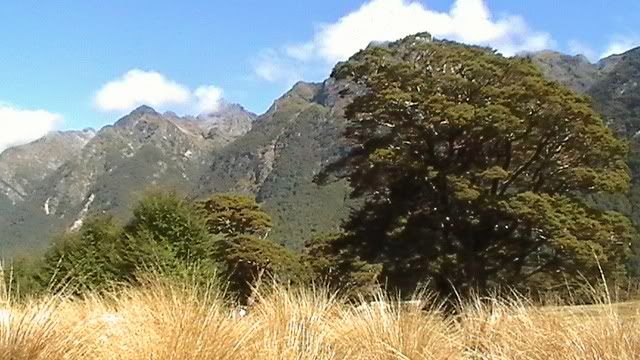
The area around the Mirror Lakes
Then it was time to test Tutu’s driving ability. Since we were running a little ahead of schedule, Daisy decided to pull into a secret side path that was super windy and narrow. Tutu, to his credit, was doing a great job navigating down it until we encountered another large bus coming from the other direction. Since there was only space for one vehicle at a time, we were forced to back up and do the whole thing in reverse. Given our high energy at the time, we were able to provide plenty of support and encouragement in the form of mindless shouting and chanting. Tutu was able to back out of there with only mild difficulty, so we gave him a big round of applause. Once we were able to actually get down the road, we discovered this great mountain lake surrounded by lots of moss-covered trees. I took plenty of pictures, of course, and found it hard to stop constantly reaching for my camera.

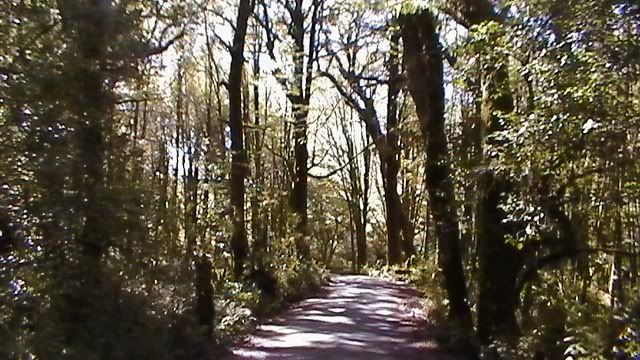
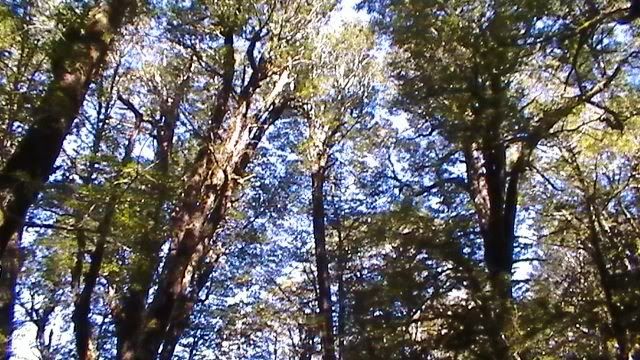

The narrow road that Tutu had to navigate down




Hanging out by the lake
We continued our drive deeper into the Fiordland and were granted some truly awe-inspiring views out the window. At just about half-way, Daisy got on the intercom and informed us that, unfortunately, we wouldn’t be staying in Gunn’s Camp that night. That’s supposed to be the “authentic, roughing-in” stop of the Stray tour, where you stay at an old mining camp used by working families way back in the day. A lot of people complain about that stop, saying that it’s infested with sand flies and pretty run-down, but other people really like the historical feel of the place. We didn’t get to form either opinion, though, because it had been completely booked out by another group that night. Instead, we were forced to head back into Te Anau to spend the night there for $29/night, which is a bit steep for a backpackers. There were two silver linings to this plan, however. The first was that, since we were traveling further in the evening, we didn’t have to get up at an ungodly hour the next day, and two, all of the rooms were singles. For the first time since August 14th, I was able to sleep in my own room, so that was just heaven. I honestly didn’t care about Gunn’s Camp at all after hearing that wonderful news.



Our view from inside the bus
The reason that Gunn’s Camp exists at all is that during the Depression, workers were needed in the area to build the Homer Tunnel. It’s this funky little passage through the mountain that’s completely carved out by hand, so you can see all of the uneven chisel marks on the sides instead of those boring, concrete ones you see everywhere. It’s also incredibly small and narrow to get through, and until recently, there wasn’t a stop light on either side to direct traffic, so I guess that used to be an interesting study of right-of-way laws. Once we were out of there, we were treated to the best view of the whole day so far and got some great looks at the valley floor. There was just one last stop before reaching Milford Sound: the Chasm. It’s not quite as dramatic as it sounds, but it was a nice little break before the main event. It’s basically a fifteen minute walk through the woods before you reach a miniature waterfall that flows in such a way that all of the surrounding rock walls have been worn completely smooth and glass-like in appearance. That was a cool teaser for the real deal just around the corner.




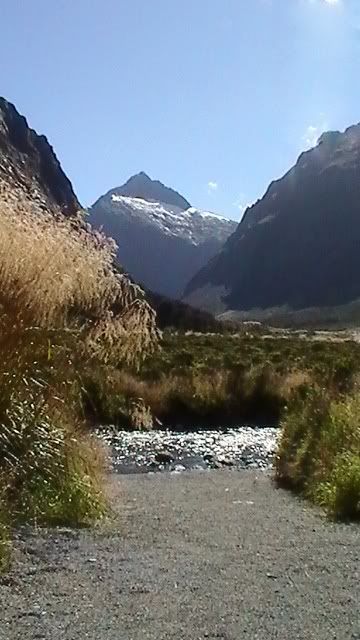

Coming out of the Homer Tunnel into the heart of the Fiordland






The Chasm
We finally, finally made it to Milford Sound after all of the little stop breaks. We were just in time, too. The boat was supposed to leave at 2pm, and we arrived just after 1:50pm. It was pretty close, so we had to get out and run for the office. I have a feeling that they would have held the boat for so many people, but we didn’t want to risk it. We rushed in with our tickets and boarded the ship just before it was set to disembark, so we didn’t have a lot of time to take in the view until we had already set sail. The most prominent feature of Milford Sound is Mitre Peak, the triangular mountain right up the center of the entrance. It’s the image that’s always in brochures and gets its name because it resembles the hat of a bishop. The fjord itself runs 15km from the Tasman Sea to Dale Point and has been consistently rated as New Zealand's most popular tourist destination, despite its remote location. The Maori used to fish and hunt seals in the area, and it has gotten a lot of international attention for its incredible beauty. I guess it's also supposed to be one of the wettest places in New Zealand, and the constant rainfall creates hundreds of permanent and temporary waterfalls that run over the side of the cliff. The first one you see at the entrance is called Cascade Range.






Arriving at Milford Sound with Mitre Peak in the background
Luckily, we arrived on a beautiful day with clear blue skies, but it was very cold and windy. Seriously windy. We all had trouble keeping our hats and jackets from blowing overboard, and you can tell how difficult it was to keep my hair under control from the photos. The crew were kind enough to pass out free tea and coffee in the cabin down below, though, so whenever we got a little too cold up-top, we could always go and watch from the inside. I tried to stay above deck as much as possible, but it was nice to have the option for a breather every once in a while. The cruise itself lasted about two hours and went the whole length of the "sound" and back. Pretty spectacular. We passed the Cascade Range Waterfall on the way out of the harbor, and from that point on, we could hardly go twenty seconds without seeing some form of waterfall on the sidelines.




Setting out from the harbor
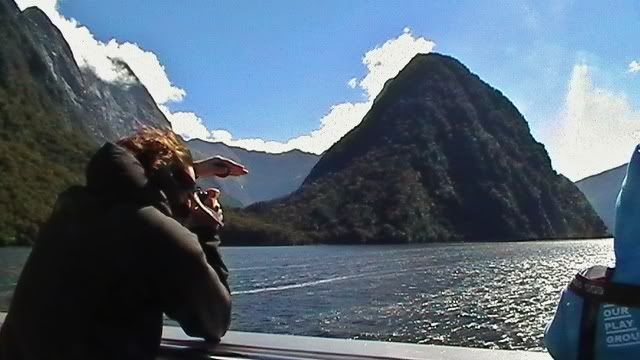
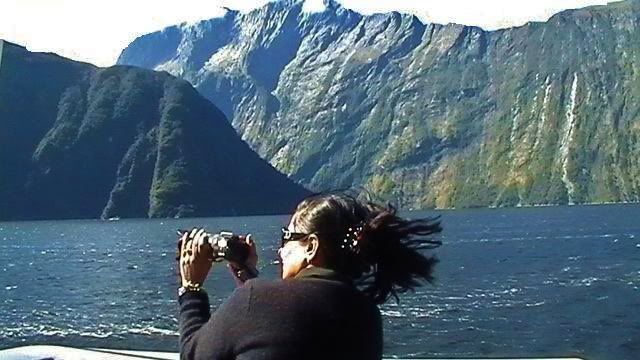
Battling the wind
I don't have a whole lot of commentary on the cruise itself - thank God - because it was mostly just standing on a boat and looking at gorgeous scenery. Definitely not boring, but not a whole lot to write about. I do remember the names of a few prominent peaks, however, so I'll go over those very quickly. The first one is simply known as "The Lion" (1,302 meters) because...it kind of looks like a lion with a big mane and everything. It's crouching down with its head raised just past the famous view of Mitre Peak.




See the Lion? "Remember who you are, Simba."
The other one that I remember by name is known as "The Elephant" (1,517 meters) because it resembles the head of an elephant. It's right next to the Lion and takes a little bit more imagination to see. Right at the base of its trunk, you can make out Stirling Falls, the second major waterfall of the trip at 146 meters. That particular waterfall was pretty cool because we could see from really far away and knew it was coming up, and then the boat operators kept teasing us by skimming around the other side. We finally did get to see it up close and personal on the way back. I should also mention that airplanes were constantly whizzing by low over the mountains as they took people up for the aerial tours. I think that would be a pretty amazing sight, but I'm still glad that we did the boat option instead. For one, it's a whole lot cheaper, but it's also long enough to get your full money's worth. Zipping by and watching out the window doesn't really seem to do the place justice.







The Elephant and Stirling Falls
Those are the only two mountains that I remember by name, by there were several other notable peaks throughout the trip. I should also apologize for the poor quality of some of these photos. Most of the reason why this post took so long is because I had to go through practically every shot and edit them pixel by pixel with all sorts of software programs to make them useable. For whatever reason, my video camera really didn't like the lighting that day and created little sun spots all over my pictures in retaliation. It was a major pain to edit them all out, so that's why some of these are substandard in quality. It's really a shame because I had to completely throw out some great shots, but you guys can at least get the idea.




Getting further out into the fjord
The best part of the cruise was that there was always something to look at. Even though the change in scenery was very gradual and didn't really look all that different from the last bit, the general vibe of the place more than made up for any repetition. There were clouds coming over the cliffs on the highest points and seagulls flying against the wind down by the waves. Hundreds of little waterfalls were trickling off into the water on either side of us, and other boats passing by gave us some perspective of how huge the mountains really were. These were not small boats by any stretch of the imagination, and yet they look like plastic toys when compared to the surrounding scenery.

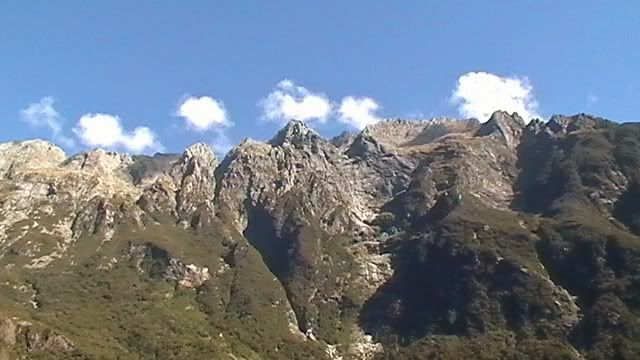





See what I mean?
We continued on in that fashion for the better part of an hour before finally reaching the Tasman Sea. The entrance to the fjord from the ocean is actually really shallow and well-hidden. In fact, once you've gone a little ways out into the deep sea and look over your shoulder, it's hard to see Milford Sound at all. Early explorers passed right by it without knowing that it went deep into the mountains. Doubtful Sound, another really pretty fjord in the same general area, is known by that name because Captain Cook saw it through a telescope and was doubtful about whether his ship would be able to make it through unscathed or not. Before that, the Maori used to park their waka, or canoes, on the shore and then venture out to hunt various animals. Even in the early twentieth century, no one really knew much about the Fiordland area or had tried to market it for tourism.




Arriving at the Tasman Sea




Looking back at the sound from the ocean
After that, it was time to retrace our steps on the other side of the fjord. It was basically the same ride, but having the sun behind us made it a whole lot easier to take photos. Plus, we got incredibly close to a few of the larger waterfalls. The battery on my camera had hit one bar at the entrance to the Tasman Sea, so I had to be careful and not take a photo of every single thing I saw, but I managed to save some of the better views. Here's the general idea.
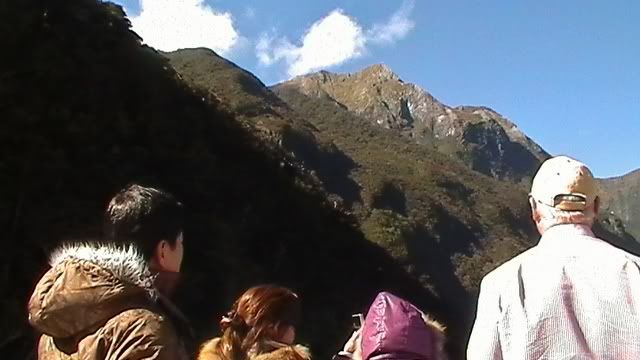






Never really gets old
Mirva was one of the last people from our old bus, so I stuck with her for most of the trip. She was a bit bummed because she had heard about people being able to see blue penguins swimming in the water or waddling around on shore, but we didn't see any that day. I guess they rarely come out when the boats are around, which makes sense. We did, however, manage to spot some fur seals chilling out in the sun. They weren't doing a whole lot, but they made those rocks looks very comfortable.

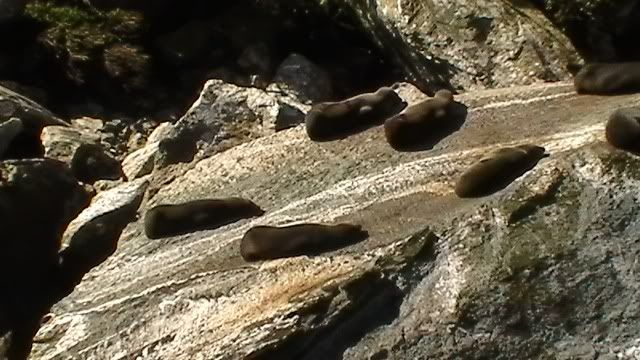
Fur Seals looking a lot like cats on a sunny deck
Remember how I mentioned Stirling Falls earlier on? Well, just past the fur seals, we were able to get that closer look that I talked about before, and wow, I really thought we were going to crash straight into it. We knew we were close when we heard the sound of rushing water, and sure enough, there it was once we'd rounded the cove. A handful of bright yellow kayaks were also chilling out at the base, getting absolutely drenched by the spray. I have no idea how long it took them to get out that far. They must've left early in the morning and been paddling all day because it took us forever to get there in a motorized boat. So while they were taking a well-earned break, we took advantage of the view and got steadily closer to the base. I (politely) elbowed a few people out of the way at the bow and got all lined up for a photo, and couldn't help but notice how we weren't stopping. Since I was right there on the nose, I had a perfect view of our prow all but scrape against the side of the cliff directly underneath the falls. Either really great driving or spectacularly bad driving, I'm not sure. Anyway, while I was nervously watching that, everyone else with a hint of common sense had taken the falling mist into account and pulled up their hoods. Then, just as soon as we had gotten our photos, the water fell right over us. We literally had to hit the deck and cover our heads to avoid getting an impromptu shower. I freaked out for a second because my lens cap was still off, but I think my camera escaped permanent damage.




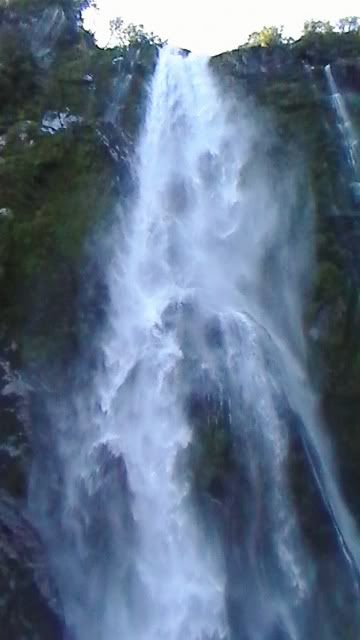
This isn't a movie, right?
There was one more final area to pass through on our way back to the starting point: Harrison Cove. It's a wide piece of shoreline not too far from the village with a great view of Lady Bowen Falls, named after the founder's wife. Unfortunately, I either didn't notice the falls or we just didn't have a great angle to see it because I don't have any photographic evidence of it, but considering how many waterfalls we'd seen already, I wasn't too disappointed.




Harrison Cove
Then it was all smooth sailing back to the harbor and the end of our Milford adventure. I think two hours is just about right for your money's worth. Anything longer than that might be a bit tedious, but anything less just wouldn't be the same. I'm really glad that we were able to go and experience it before the weather turned. Just before pulling into base, we got one more look at that first waterfall from a different angle. With the light reflected behind us, the view was even better, and I had just enough battery life to snap off a few more shots of it. If you look closely, you can just make out the hint of a rainbow at the base, which is just awesome.





Back to where we started from
The rest of the day was fairly predictable. Even though we had had an amazing day and still couldn't believe how anything that beautiful could be real, we were incredibly tired and looking forward to those much-promised single rooms in Te Anau. We loaded back into the bus and made our way back through the Fiordland without much incident. There was one point, however, when we pulled over for a photo (which I couldn't participate in, unfortunately) and a little Kea bird came right up to us. Now, most people in New Zealand know about Keas because they're cute, mischievous things that like to take apart your cars. People in the South Island have to be careful about leaving vans unattended for long in the mountains because Keas love to tear up the rubber. You could go away and come back to find your car completely picked clean of insulation. It's also the name of a popular camper van rental company, so you always see vans driving by with pictures of Keas drawn on them. Anyway, this little guy was adorable and very curious about us, so he hopped right up to the van and sat on the bottom step for a good couple of minutes. As you can see, they're a type of parrot and native only to New Zealand. Since I couldn't take a picture at the time, this one I found on Google will have to suffice.
And that was it. We made it to Te Anau around dinner time and only had time to eat, shower, and get ready for bed before getting up early again the next day. Tune in next time for one of my favorite places so far: Stewart Island! Look forward to it!

Kea says goodbye
We had a fairly early start that morning - nothing as miserable as a 6 or 7am departure, but somewhere in the ballpark of 8 or 8:30 - so that meant setting the alarm clock and making sure all of my stuff was good to go the night before. I was pleasantly surprised to see some familiar faces when we boarded, so I stuck with people like Mirva and Natalie for the trip to Milford Sound. Now, Milford Sound is not actually a “sound” in scientific terms - more like a fjord, apparently - but it’s reputed to be one of the most beautiful spots of New Zealand. I had been looking forward to seeing it because so many people had been telling me about their experiences there. I didn’t want to put my expectations too high in case it was super disappointing, but I had a feeling that it was going to be amazing.
To get to Milford Sound, we had to travel northwest of Queenstown through Te Anau, which is a little backwards when you look at the route map. You would think that it’d make more sense to hit that area before Queenstown and then work your way south instead of having to go up and come down again, but then again, Stray isn’t the most organized travel company in the world. I’m sure there’s a logical reason for doing it that way somewhere.
The trip to Te Anau was as predictable as you’d expect. Our new guide was a driver-in-training named Tutu, who was being coached along by Daisy. Some of you might remember that I was briefly on a bus with Daisy between Taupo and Tongariro National Park, so it was a bit surreal to see him again after all of the other stuff that had happened since then. Tutu and Daisy seemed pretty cool even though I didn’t really have much of a chance to talk to them. Tutu was a chill, younger guy who appeared to know what he was doing 95% of the time, and Daisy just chimed in that other 5% to add supplementary information. Our new bus was named “Bex,” and even though it didn’t have as many cool features as “Richard,” it was still pretty comfy and didn’t break down on us or anything.
We were all a little quiet and groggy for the first leg of the ride because backpackers, in general, are not big on mornings, so the ride to Te Anau mostly involved us staring out the windows and listening to our iPods. Te Anau (pronounced Teh AH-Now) is a nice little town not too far out of Queenstown. It was a definite change of pace after the last couple of days, but in a good way. We only stopped there for about an hour, so it’s hard to say if there’s anything really in Te Anau, but it’s on a gorgeous lake and has a generally peaceful vibe to it. I had originally planned on hopping off there for an extra night instead of continuing on to Milford Sound right away because I wanted to see the glow worm caves there, but since Stray’s scheduling was lame (as usual), that would have meant staying several extra days. Even though I was disappointed about that, I knew that I would get to see the Waitomo Caves up in the North Island eventually, and those are, apparently, just as good. Next time, I suppose.


Downtown Te Anau, booking office on the right
There’s generally a set formula once you’re on the Stray bus: get on, go through roll call, announce the itinerary, drive, pass around a clipboard for accommodation that night, pass along a clipboard to sign up for upcoming activities, and then arrive at the destination. For some reason, the plan deviated from this routine between Queenstown and Milford Sound because instead of signing up for the Milford Sound cruise and/or Stewart Island ferry on the bus and then allowing the driver to book it for you, we had to do it ourselves. Normally, I wouldn’t really mind about that because it’s a pretty easy process, but since the entire bus had to do the exact same thing in a tiny little office, that meant an incredibly long line for just an hour-long stop. Luckily, I had the foresight to go eat first and then head back to the Real Journeys booking office after the rush had ended, thereby beating both lines. Daisy (who is a great lover of pies) had pointed out one bakery in particular, so I decided to stop there for lunch.
It turned out to be a fabulous idea because as soon as I walked in the door, my eyes immediately zoomed in one thing - Cornish pasties. Now, pasties are probably my favorite things in the whole wide world, and I firmly believe that they can cure polio and end global warming, so I was thrilled to see them on the menu. My grandmother had the absolute best recipe for them, and Mom and I have tried out best to copy her results. I have no delusions that our version is even close to how they were originally supposed to taste, but since they’re so good, I honestly don’t care. Needless to say, I was intrigued to try the official kind in a real bakery. Jodie informed me that the only way to tell that it’s a genuine Cornish pastie is to see if it has the ridges on the top like a football. I guess they were originally eaten by coal miners as a lunch snack, and since their hands were covered with coal dust, those outer ridges were designed to give them something to hold onto while they ate. After they were done, that part was left and thrown away. Makes sense. So I ordered the pastie, and although it was good and probably the most authentic version outside of the UK, I still prefer the kind that I grew up with. This kind was too complicated with carrots and extra seasoning inside, and the kind back home is just salt and pepper to taste, which means it’s not as salty. Good to know that our version is even better than the official one.

Heaven
The other place that I had wanted to stop at in Te Anau was the Redcliff Bar and Restaurant. To explain why, I’ll just lift an entire passage out of my Lord of the Rings Guidebook: “During filming in the area, the stars frequented the café, and part-owner Megan Harvey has an autographed T-Shirt to prove it. One evening, dinner coincided with poetry-reading night. After various recitations, a deep voice resounded, reciting a Shakespearean sonnet. The reading finished, the audience applauded, and John Rhys-Davies (Gimli) took a deep bow and left.” Since that was literally two minutes away from the bakery, I thought I’d be a good idea to check that place out as well. Unfortunately, it was closed on that particular day, but it wouldn’t have really mattered anyway. The menu had been left outside, and everything on it was way outside of my price range. It looked like a pretty fancy place with $40 steaks and whatnot, so it was probably for the best that I wasn’t able to stop in. I was able to take plenty of pictures of the front, though, so that was all I really needed.




I'm such a nerd
After all of that, I finally made it back to the bookings office and got my ticket for the Milford Sound cruise. Since you have to book the Stewart Island ferry a few days in advance as well, I picked up one of those too. The only problem was that I had to tell them right there how long I was planning to be on Stewart Island, and I hadn’t made up my mind about that yet. I was originally thinking two nights because one night wouldn’t justify the cost, and anything more seemed like too long, but they convinced me to book a return ferry after three nights. In hindsight, I’m really glad that they did. I was thinking that since there are only 400 permanent residents on the island with only one store and no banks, there wouldn’t be much to do there, but I ended up having a great time on Stewart Island. I’ll go more into that later and save that for the next post.
Then it was almost time to leave Te Anau and get back on the road. I spent the last ten or fifteen minutes walking up and down the streets and taking pictures. They had a garden with a little replica of the surrounding area in one courtyard, so that was cute. I wasn’t able to go to the glow worm caves, but at least I was able to look at the miniature and see where they were supposed to be. I’ll take my victories whenever I can get them


A cute miniature replica of the Lake Te Anau area


Overlooking Lake Te Anau
After Te Anau, we kept driving into the mountains, and the scenery gradually got more and more beautiful throughout the day. The road between Queenstown and Te Anau had been relatively flat with a few trees and lakes to look at, but after that, it was like entering a whole other world. Great monolithic slabs of rock rose straight out of the ground and disappeared into patches of low-lying cloud, and highland meadows stretched on as far as the eye could see. The Fiordland National Park is a truly gorgeous place. I took so many photos, but I don’t think any of them even come close to showing you guys what it really looked like. My camera reacted strangely to the way the light hit the lens, so half of them have an annoying glare on them. I’ll just show you some of the more useable pictures that I managed to save.




Stopping on the side of the road in Fiordland
We stopped at two spots in particular. The first was just a little valley with a nice view of the surrounding hills and mountains. We stopped there for five minutes to take photos and take in the scenery. We had been going through a lot of thick forests and overgrowth before that point, so it was cool to finally come out into the open and see this great landscape in front of us. Knowing that it was only going to get better was also great for getting people excited. The second place that we stopped was at the Mirror Lakes area about one third of the way into the Fiordland. Much like Lake Matheson, these small lakes are great for catching reflections of the surrounding mountains and giving great views. I guess it was a little too cloudy to catch those really nice mirror images, but they were pretty enough all by themselves. Again, my camera didn’t really do it justice, but I guess that’s the way it goes. We briefly dropped into a visitor center for a bathroom break and another photo op, but that was more of a pit stop.




The area around the Mirror Lakes
Then it was time to test Tutu’s driving ability. Since we were running a little ahead of schedule, Daisy decided to pull into a secret side path that was super windy and narrow. Tutu, to his credit, was doing a great job navigating down it until we encountered another large bus coming from the other direction. Since there was only space for one vehicle at a time, we were forced to back up and do the whole thing in reverse. Given our high energy at the time, we were able to provide plenty of support and encouragement in the form of mindless shouting and chanting. Tutu was able to back out of there with only mild difficulty, so we gave him a big round of applause. Once we were able to actually get down the road, we discovered this great mountain lake surrounded by lots of moss-covered trees. I took plenty of pictures, of course, and found it hard to stop constantly reaching for my camera.




The narrow road that Tutu had to navigate down




Hanging out by the lake
We continued our drive deeper into the Fiordland and were granted some truly awe-inspiring views out the window. At just about half-way, Daisy got on the intercom and informed us that, unfortunately, we wouldn’t be staying in Gunn’s Camp that night. That’s supposed to be the “authentic, roughing-in” stop of the Stray tour, where you stay at an old mining camp used by working families way back in the day. A lot of people complain about that stop, saying that it’s infested with sand flies and pretty run-down, but other people really like the historical feel of the place. We didn’t get to form either opinion, though, because it had been completely booked out by another group that night. Instead, we were forced to head back into Te Anau to spend the night there for $29/night, which is a bit steep for a backpackers. There were two silver linings to this plan, however. The first was that, since we were traveling further in the evening, we didn’t have to get up at an ungodly hour the next day, and two, all of the rooms were singles. For the first time since August 14th, I was able to sleep in my own room, so that was just heaven. I honestly didn’t care about Gunn’s Camp at all after hearing that wonderful news.



Our view from inside the bus
The reason that Gunn’s Camp exists at all is that during the Depression, workers were needed in the area to build the Homer Tunnel. It’s this funky little passage through the mountain that’s completely carved out by hand, so you can see all of the uneven chisel marks on the sides instead of those boring, concrete ones you see everywhere. It’s also incredibly small and narrow to get through, and until recently, there wasn’t a stop light on either side to direct traffic, so I guess that used to be an interesting study of right-of-way laws. Once we were out of there, we were treated to the best view of the whole day so far and got some great looks at the valley floor. There was just one last stop before reaching Milford Sound: the Chasm. It’s not quite as dramatic as it sounds, but it was a nice little break before the main event. It’s basically a fifteen minute walk through the woods before you reach a miniature waterfall that flows in such a way that all of the surrounding rock walls have been worn completely smooth and glass-like in appearance. That was a cool teaser for the real deal just around the corner.






Coming out of the Homer Tunnel into the heart of the Fiordland






The Chasm
We finally, finally made it to Milford Sound after all of the little stop breaks. We were just in time, too. The boat was supposed to leave at 2pm, and we arrived just after 1:50pm. It was pretty close, so we had to get out and run for the office. I have a feeling that they would have held the boat for so many people, but we didn’t want to risk it. We rushed in with our tickets and boarded the ship just before it was set to disembark, so we didn’t have a lot of time to take in the view until we had already set sail. The most prominent feature of Milford Sound is Mitre Peak, the triangular mountain right up the center of the entrance. It’s the image that’s always in brochures and gets its name because it resembles the hat of a bishop. The fjord itself runs 15km from the Tasman Sea to Dale Point and has been consistently rated as New Zealand's most popular tourist destination, despite its remote location. The Maori used to fish and hunt seals in the area, and it has gotten a lot of international attention for its incredible beauty. I guess it's also supposed to be one of the wettest places in New Zealand, and the constant rainfall creates hundreds of permanent and temporary waterfalls that run over the side of the cliff. The first one you see at the entrance is called Cascade Range.






Arriving at Milford Sound with Mitre Peak in the background
Luckily, we arrived on a beautiful day with clear blue skies, but it was very cold and windy. Seriously windy. We all had trouble keeping our hats and jackets from blowing overboard, and you can tell how difficult it was to keep my hair under control from the photos. The crew were kind enough to pass out free tea and coffee in the cabin down below, though, so whenever we got a little too cold up-top, we could always go and watch from the inside. I tried to stay above deck as much as possible, but it was nice to have the option for a breather every once in a while. The cruise itself lasted about two hours and went the whole length of the "sound" and back. Pretty spectacular. We passed the Cascade Range Waterfall on the way out of the harbor, and from that point on, we could hardly go twenty seconds without seeing some form of waterfall on the sidelines.




Setting out from the harbor


Battling the wind
I don't have a whole lot of commentary on the cruise itself - thank God - because it was mostly just standing on a boat and looking at gorgeous scenery. Definitely not boring, but not a whole lot to write about. I do remember the names of a few prominent peaks, however, so I'll go over those very quickly. The first one is simply known as "The Lion" (1,302 meters) because...it kind of looks like a lion with a big mane and everything. It's crouching down with its head raised just past the famous view of Mitre Peak.




See the Lion? "Remember who you are, Simba."
The other one that I remember by name is known as "The Elephant" (1,517 meters) because it resembles the head of an elephant. It's right next to the Lion and takes a little bit more imagination to see. Right at the base of its trunk, you can make out Stirling Falls, the second major waterfall of the trip at 146 meters. That particular waterfall was pretty cool because we could see from really far away and knew it was coming up, and then the boat operators kept teasing us by skimming around the other side. We finally did get to see it up close and personal on the way back. I should also mention that airplanes were constantly whizzing by low over the mountains as they took people up for the aerial tours. I think that would be a pretty amazing sight, but I'm still glad that we did the boat option instead. For one, it's a whole lot cheaper, but it's also long enough to get your full money's worth. Zipping by and watching out the window doesn't really seem to do the place justice.







The Elephant and Stirling Falls
Those are the only two mountains that I remember by name, by there were several other notable peaks throughout the trip. I should also apologize for the poor quality of some of these photos. Most of the reason why this post took so long is because I had to go through practically every shot and edit them pixel by pixel with all sorts of software programs to make them useable. For whatever reason, my video camera really didn't like the lighting that day and created little sun spots all over my pictures in retaliation. It was a major pain to edit them all out, so that's why some of these are substandard in quality. It's really a shame because I had to completely throw out some great shots, but you guys can at least get the idea.




Getting further out into the fjord
The best part of the cruise was that there was always something to look at. Even though the change in scenery was very gradual and didn't really look all that different from the last bit, the general vibe of the place more than made up for any repetition. There were clouds coming over the cliffs on the highest points and seagulls flying against the wind down by the waves. Hundreds of little waterfalls were trickling off into the water on either side of us, and other boats passing by gave us some perspective of how huge the mountains really were. These were not small boats by any stretch of the imagination, and yet they look like plastic toys when compared to the surrounding scenery.







See what I mean?
We continued on in that fashion for the better part of an hour before finally reaching the Tasman Sea. The entrance to the fjord from the ocean is actually really shallow and well-hidden. In fact, once you've gone a little ways out into the deep sea and look over your shoulder, it's hard to see Milford Sound at all. Early explorers passed right by it without knowing that it went deep into the mountains. Doubtful Sound, another really pretty fjord in the same general area, is known by that name because Captain Cook saw it through a telescope and was doubtful about whether his ship would be able to make it through unscathed or not. Before that, the Maori used to park their waka, or canoes, on the shore and then venture out to hunt various animals. Even in the early twentieth century, no one really knew much about the Fiordland area or had tried to market it for tourism.




Arriving at the Tasman Sea




Looking back at the sound from the ocean
After that, it was time to retrace our steps on the other side of the fjord. It was basically the same ride, but having the sun behind us made it a whole lot easier to take photos. Plus, we got incredibly close to a few of the larger waterfalls. The battery on my camera had hit one bar at the entrance to the Tasman Sea, so I had to be careful and not take a photo of every single thing I saw, but I managed to save some of the better views. Here's the general idea.







Never really gets old
Mirva was one of the last people from our old bus, so I stuck with her for most of the trip. She was a bit bummed because she had heard about people being able to see blue penguins swimming in the water or waddling around on shore, but we didn't see any that day. I guess they rarely come out when the boats are around, which makes sense. We did, however, manage to spot some fur seals chilling out in the sun. They weren't doing a whole lot, but they made those rocks looks very comfortable.


Fur Seals looking a lot like cats on a sunny deck
Remember how I mentioned Stirling Falls earlier on? Well, just past the fur seals, we were able to get that closer look that I talked about before, and wow, I really thought we were going to crash straight into it. We knew we were close when we heard the sound of rushing water, and sure enough, there it was once we'd rounded the cove. A handful of bright yellow kayaks were also chilling out at the base, getting absolutely drenched by the spray. I have no idea how long it took them to get out that far. They must've left early in the morning and been paddling all day because it took us forever to get there in a motorized boat. So while they were taking a well-earned break, we took advantage of the view and got steadily closer to the base. I (politely) elbowed a few people out of the way at the bow and got all lined up for a photo, and couldn't help but notice how we weren't stopping. Since I was right there on the nose, I had a perfect view of our prow all but scrape against the side of the cliff directly underneath the falls. Either really great driving or spectacularly bad driving, I'm not sure. Anyway, while I was nervously watching that, everyone else with a hint of common sense had taken the falling mist into account and pulled up their hoods. Then, just as soon as we had gotten our photos, the water fell right over us. We literally had to hit the deck and cover our heads to avoid getting an impromptu shower. I freaked out for a second because my lens cap was still off, but I think my camera escaped permanent damage.





This isn't a movie, right?
There was one more final area to pass through on our way back to the starting point: Harrison Cove. It's a wide piece of shoreline not too far from the village with a great view of Lady Bowen Falls, named after the founder's wife. Unfortunately, I either didn't notice the falls or we just didn't have a great angle to see it because I don't have any photographic evidence of it, but considering how many waterfalls we'd seen already, I wasn't too disappointed.




Harrison Cove
Then it was all smooth sailing back to the harbor and the end of our Milford adventure. I think two hours is just about right for your money's worth. Anything longer than that might be a bit tedious, but anything less just wouldn't be the same. I'm really glad that we were able to go and experience it before the weather turned. Just before pulling into base, we got one more look at that first waterfall from a different angle. With the light reflected behind us, the view was even better, and I had just enough battery life to snap off a few more shots of it. If you look closely, you can just make out the hint of a rainbow at the base, which is just awesome.





Back to where we started from
The rest of the day was fairly predictable. Even though we had had an amazing day and still couldn't believe how anything that beautiful could be real, we were incredibly tired and looking forward to those much-promised single rooms in Te Anau. We loaded back into the bus and made our way back through the Fiordland without much incident. There was one point, however, when we pulled over for a photo (which I couldn't participate in, unfortunately) and a little Kea bird came right up to us. Now, most people in New Zealand know about Keas because they're cute, mischievous things that like to take apart your cars. People in the South Island have to be careful about leaving vans unattended for long in the mountains because Keas love to tear up the rubber. You could go away and come back to find your car completely picked clean of insulation. It's also the name of a popular camper van rental company, so you always see vans driving by with pictures of Keas drawn on them. Anyway, this little guy was adorable and very curious about us, so he hopped right up to the van and sat on the bottom step for a good couple of minutes. As you can see, they're a type of parrot and native only to New Zealand. Since I couldn't take a picture at the time, this one I found on Google will have to suffice.
And that was it. We made it to Te Anau around dinner time and only had time to eat, shower, and get ready for bed before getting up early again the next day. Tune in next time for one of my favorite places so far: Stewart Island! Look forward to it!

Kea says goodbye